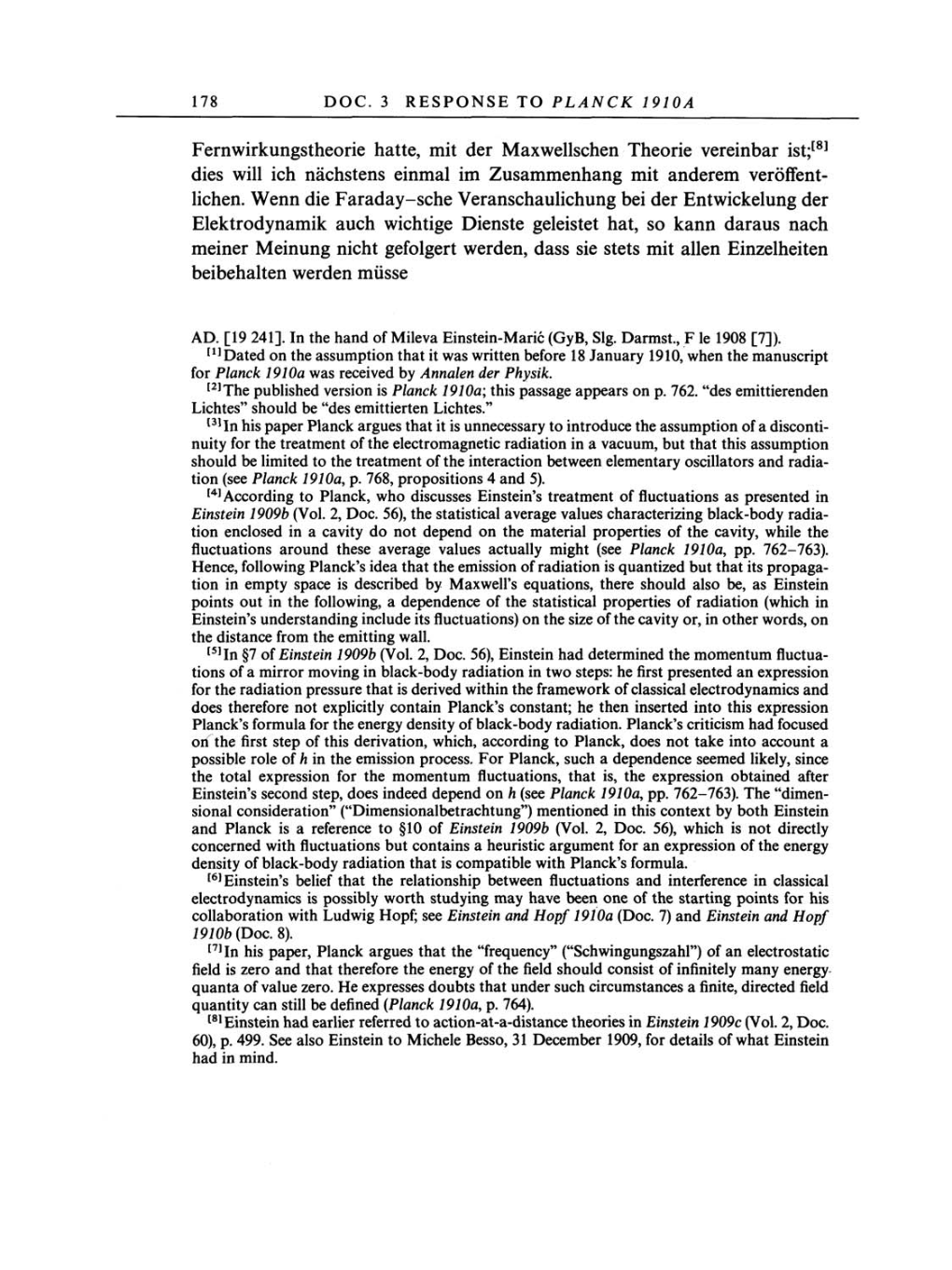178 DOC.
3
RESPONSE TO PLANCK 1910A
Fernwirkungstheorie hatte,
mit der Maxwellschen Theorie
vereinbar
ist;[8]
dies
will ich
nächstens einmal
im
Zusammenhang
mit anderem veröffent-
lichen.
Wenn die
Faraday-sche
Veranschaulichung
bei
der
Entwickelung
der
Elektrodynamik
auch
wichtige
Dienste
geleistet hat,
so
kann daraus
nach
meiner
Meinung
nicht
gefolgert werden,
dass
sie stets
mit allen Einzelheiten
beibehalten werden müsse
AD.
[19 241].
In the hand of Mileva Einstein-Maric
(GyB, Slg.
Darmst.,
F
le 1908
[7]).
[1]Dated
on
the
assumption
that
it
was
written before
18 January
1910,
when the
manuscript
for Planck
1910a
was
received
by
Annalen
der
Physik.
[2]The
published
version
is
Planck
1910a;
this
passage appears
on p.
762.
"des emittierenden
Lichtes" should
be
"des emittierten Lichtes."
[3]In
his
paper
Planck
argues
that
it
is unnecessary
to
introduce the
assumption
of
a
disconti-
nuity
for the
treatment
of
the
electromagnetic
radiation
in
a
vacuum,
but that this
assumption
should
be
limited
to
the
treatment
of
the
interaction between
elementary
oscillators and radia-
tion
(see
Planck
1910a,
p.
768, propositions
4
and
5).
[4]According
to Planck,
who discusses Einstein's
treatment
of fluctuations
as presented
in
Einstein
1909b
(Vol. 2,
Doc.
56),
the statistical
average
values
characterizing black-body
radia-
tion enclosed
in
a
cavity
do
not
depend
on
the material
properties
of the
cavity,
while
the
fluctuations around these
average
values
actually might
(see
Planck
1910a, pp. 762-763).
Hence,
following
Planck's idea
that
the emission of radiation
is
quantized
but that
its
propaga-
tion
in
empty space
is
described
by
Maxwell's
equations,
there should also
be,
as
Einstein
points
out
in the
following,
a
dependence
of the statistical
properties
of radiation
(which
in
Einstein's
understanding
include
its fluctuations)
on
the
size
of
the cavity or, in
other
words,
on
the distance from the
emitting wall.
[5]In
§7
of
Einstein 1909b
(Vol.
2,
Doc.
56),
Einstein
had determined the
momentum
fluctua-
tions of
a
mirror
moving
in
black-body
radiation in
two
steps:
he
first presented
an
expression
for the radiation
pressure
that
is
derived within the
framework
of
classical electrodynamics
and
does therefore
not explicitly
contain Planck's
constant; he
then
inserted into
this
expression
Planck's
formula for the
energy density
of
black-body
radiation. Planck's criticism had focused
on
the first
step
of this
derivation, which,
according
to Planck,
does
not
take into
account
a
possible
role of
h in
the emission
process.
For
Planck,
such
a
dependence
seemed
likely,
since
the total
expression
for the
momentum fluctuations,
that
is,
the
expression
obtained after
Einstein's second
step,
does
indeed
depend
on
h
(see
Planck
1910a,
pp. 762-763).
The
"dimen-
sional consideration"
("Dimensionalbetrachtung")
mentioned
in
this
context
by
both Einstein
and
Planck
is
a
reference
to
§10
of Einstein
1909b
(Vol.
2,
Doc.
56),
which
is not
directly
concerned with fluctuations but contains
a
heuristic
argument
for
an
expression
of
the
energy
density
of
black-body
radiation that
is compatible
with Planck's formula.
[6]Einstein's
belief
that
the
relationship
between fluctuations and interference
in
classical
electrodynamics is possibly
worth
studying
may
have been
one
of the
starting
points
for his
collaboration with
Ludwig Hopf;
see
Einstein and
Hopf 1910a
(Doc.
7)
and Einstein
and
Hopf
1910b (Doc.
8).
[7]In
his
paper,
Planck
argues
that
the
"frequency" ("Schwingungszahl")
of
an
electrostatic
field is
zero
and that therefore the
energy
of the
field
should consist of
infinitely many energy
quanta
of
value
zero.
He
expresses
doubts
that
under such circumstances
a
finite,
directed
field
quantity
can
still be
defined
(Planck 1910a,
p. 764).
[8]Einstein had earlier referred
to
action-at-a-distance theories
in
Einstein
1909c
(Vol.
2,
Doc.
60), p.
499. See
also Einstein
to
Michele
Besso, 31
December
1909,
for details of what Einstein
had
in
mind.
